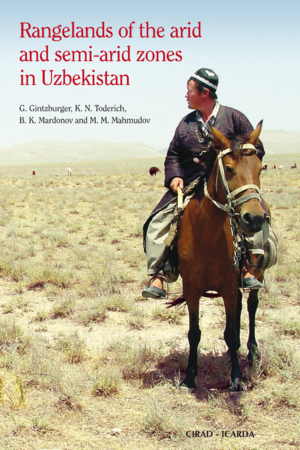Gintzburger et al., Rangelands in Uzbekistan, 2003
G. Gintzburger, K. N. Toderich, B. K. Mardonov and M. M. Mahmudov, 2003. Rangelands of the arid and semi-arid zones in Uzbekistan. CIRAD - ICARDA. 432 p. ISBN 978-2-7592-0673-5
- CIRAD : Centre de coopération internationale en recherche agronomique pour le développement
- ICARDA : International Center for Agricultural Research in the Dry Areas
With the support of:
- CIRAD-EMVT, Département d’Elevage et de Médecine Vétérinaire
- ECONAP, Programme Ecosystèmes naturels et pastoraux, France
- Uzbekistan Scientific Production Centre of Agricultural Research, Uzbekistan
- Academy of Science of Uzbekistan, Samarkand Division, Uzbekistan
- Karakul Sheep and Desert Ecology Research Institute, Samarkand, Uzbekistan
- World Bank
- Global Livestock CRSP, Livestock Development and Rangeland Conservation Tools Project in Central Asia, USA
- USDA/ARS, Central Asian Range and Sheep Evaluation Project, USA
- Wallace Research Foundation, USA
- IGF, Fondation Internationale pour la Conservation de la Faune Sauvage, France
- INRA, Institut National de la Recherche Agronomique, France
Contents
- Forewords 9
- Preface 11
- Introduction 15
- The pastoral system 16
- A brief physico-geographical and ecological presentation of Uzbekistan 21
- The environment 22
- Geology and geomorphology 22
- Climatology and bioclimatology 26
- Arid and semi-arid soils 35
- Phytogeography 40
- Current changes in land use, crop yield and livestock numbers 45
- The flora and main vegetation types of the arid and semi-arid zones 50
- Plant family contribution to the vegetation 50
- Main vegetation types of the arid and semi-arid zones 53
- The environment 22
- Plant descriptions 87
- Ecology, biology and economic importance of arid and semi-arid rangeland plants 275
- Biological and life forms 276
- Small trees and shrubs (microphanerophytes and nanophanerophytes) 276
- Small shrubs (chamaephytes) 276
- Herbaceous plants (perennials and biannuals) 277
- Chemical composition, fodder value and palatability 278
- Toxic and medicinal plants 280
- Plants that may cause mechanical injuries to livestock 283
- Seed characteristics and germination ecology 283
- Seed morphology and germination conditions 283
- Seed viability 286
- Seed dormancy 287
- Biological and life forms 276
- Range improvement and rehabilitation in Uzbekistan 295
- Collecting and evaluating the phytogenetic resources 297
- Range improvement operations/establishment and regeneration techniques 300
- Land preparation and disturbance 301
- Seeding time 302
- Depth of seeding 303
- Seeding rate 303
- Expected improvement and production 305
- Nature reserves in Uzbekistan 313
- Reserves in desert ecosystems 315
- The Kyzylkum reserve (sandy part) 315
- The Karakul reserve (’zakaznik’) 320
- The Ecological Breeding Centre ‘Dzheiran’ 320
- Reserves of riparian forests and wetland ecosystems 322
- The Kyzylkum reserve (tugaï part) 323
- The relict riparian forest fragments of the Badai-Tugaï nature reserve 325
- The Aral-Paigambar reserve 326
- The Zerafshan reserve 327
- Reserves in the mountain ecosystem 329
- The Nuratau mountains walnut-fruit forests biosphere reserve 329
- The Gissar reserve 330
- The Chatkal biosphere reserve 332
- The Kitab geological reserve 333
- The Zaamin forest reserve 334
- Reserves in desert ecosystems 315
- General conclusions 337
- Maps 339
- Bibliography 351
- Uzbek glossary 368
- Appendix 377
- Index 405
On Pl@ntUse
All the pages describing plants have been uploaded. Only part of the remaining pages will be uploaded. See the category below.
A (scientific) transliteration has been added to the names in Russian.
